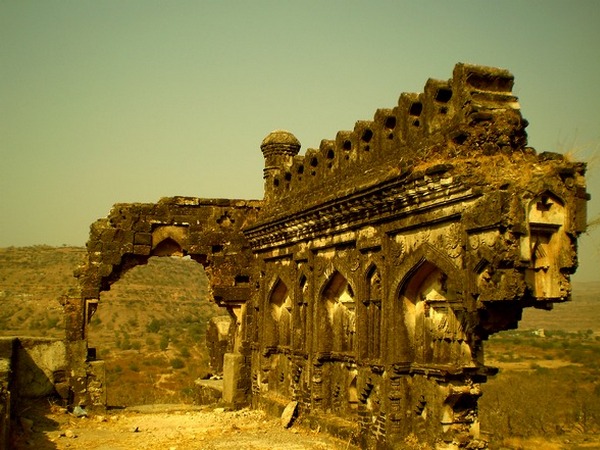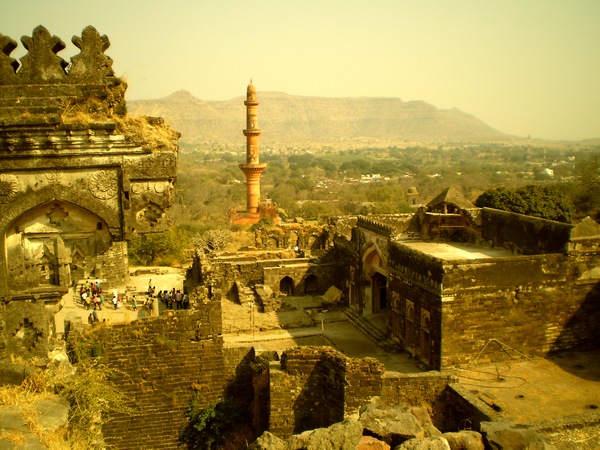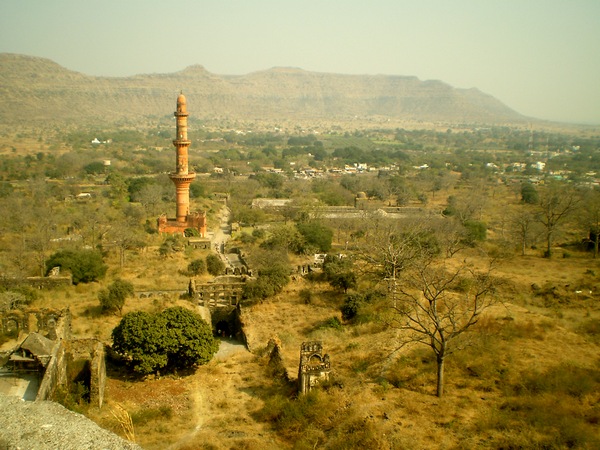Photographs: Nirdesh K Singh Nirdesh K Singh
After his piece on India's hidden gem of Chitradurga Fort, Rediff reader Nirdesh K Singh sent us this travelogue on his visit to Aurangabad's Daulatabad Fort.
Daulatabad Fort has been tragically condemned by labelling it with the whims of the King Muhammad-bin-Tughlaq of the 14th century. We have all read about the king in the school history books who could not decide where to have his capital and kept shuttling between Delhi and Daulatabad.
According to historians, Delhites used to write him abusive letters. Apparently, we Delhites then were far more civilised than the present bunch. So to teach them a lesson, Tughlaq decided to shift the capital to Daulatabad.
Also, the move was supposed to keep them safe from the frequent marauding excursions by the Mongol hordes.
Though it is believed that he forced the entire population of Delhi to move to Daulatabad but it was only the upper classes that got the moving orders. Large number of people died during the long and hot journey.
Want to share your travel story and pictures? Simply write in to getahead@rediff.co.in (subject line: 'My Travel Story'), along with pictures of the destination you're writing about. We'll publish the best ones right here on rediff.com and India Abroad!
IN PICS: The indomitable Daulatabad Fort of Aurangabad
Photographs: Nirdesh K Singh
Once in Daulatabad, people faced paucity of water and there was a general rebellion by the displaced populace. Tughlaq also realised that he could not control the North from Daulatabad and decided to shift the capital back to Delhi within two years.
Delhites smarting from the forced relocation probably were too bored of lack of seasons and the peaceful life in the foothills of Western Ghats. They were more at home fighting the sundry invaders from the North in numbing winter and scorching summers keeping ennui in check.
Some historians call Tughlaq visionary instead of using epithets of mad king. During his reign, Delhi Sultanate expanded from Peshawar to Madurai and Sindh to Assam. The historians believe the reason for moving capital from Delhi to Daulatabad was to establish a second capital.
Even the British used the concept of two capitals. He also introduced copper and brass coins as token currency which could be used at par with silver and gold coins. But the ever ingenious Delhites forged the coins and the experiment failed. Another blunder was the invasion of Himachal.
His misfortune was that most of these experiments failed, putting financial pressure ultimately leading to disruption of Delhi Sultanate.
IN PICS: The indomitable Daulatabad Fort of Aurangabad
Photographs: Nirdesh K Singh
Denizens of Daulatabad should have learned from the inhabitants of Chitradurga Fort inhabitants about their rain harvesting techniques.
This you find odd because the same set of people like Yadavas and Rashtrakutas ruled over this general area of Maharashtra and Karnataka. So they should have had the services of the same pool of architects.
Today, people in the area have still not learned anything from the Daulatabad debacle. Aurangabad today gets water once in four days. And this is the period just after the monsoons. Imagine what will happen in the coming months. But this is of not much concern to you. What does concern you is that Aurangabad is the beer capital of India.
More alarmingly, with no water in the Jayakwadi dam that serves the city, you might have a beer buzz free coming summer. But, all is not lost; some water has been released from the Bhandardara Dam. You actually saw this water making its way from Ahmednagar to Aurangabad. So Cheers!
However, the fort has far more chequered history than just being synonymous with a crazy king. The fort was founded in the 12th century by Yadavas who were the original inhabitants of Daulatabad. It was named Devgiri then. You feel certain kinship towards the Devgiri Fort as the Yadavas came from your ancestral land of Mathura.
The fort is amazing piece of human labour and natural surprises. In an area surrounded with rolling hills, this conical hill stands tall and alone by some miracle of nature.
While the volcanoes erupted in the neighbourhood, lava flowed to form the chained hills in the distance. But here it seems the earth opened up in this crevice below, lava spewed, and then it just stopped, the lava inexplicably froze forming this hill. The initial builders chiselled the slopes of the hill so that the 50m vertical stone walls made the fort impregnable on three sides.
IN PICS: The indomitable Daulatabad Fort of Aurangabad
Photographs: Nirdesh K Singh
As you enter the fort, you are greeted by this tall minar Chand Minar. It used to be covered with Persian glazed tiles.
Now they have whitewashed it in faded orange colour. I want to strangle the person who ordered this colour. The minar was built by Ahmed Shah II to celebrate the capture of the fort. To approach from the front one has to go through three bastions of fortified walls.
Then it is a walk on a narrow brid#8805 be careful as the bridge is wobbly with loose wooden slabs -- over a moat probably filled with starving crocodiles. Then there is this minor matter of walking through dark tunnels. This walk is designed to disorient you so that you are relieved when you see this opening with sun shining. You step off and plummet down 150 feet.
Last time we visited Daulatabad Fort during our college days; we took the train from Aurangabad and got off at the Daulatabad station. Then we walked for about eight kilometres. We hardly encountered anyone on the station or on the way. Then we climbed all of 200 metres to the top of the fort without breaking a sweat.
After about 25 years, I drove through the bustling town to the fort door. By 100m I was panting and my legs felt like jelly. I tried to motivate myself like the Sikh gentleman in the Hero ad by singing its jingle Hum main hai Hero but gave up and came down.
I remembered the fort as a proud edifice with a commanding view of the area when I saw it last. Today, it is a picture of neglect, the walls are crumbling and trash abounds in the rich Indian culture of defacing and dirtying our monuments.
This seems to be general sorry condition of forts in Maharashtra Ahmednagar Fort and Sinhgad Fort in Pune. I fear that the fort will be lost forever in the next 25 years if the ASI does not wake up.
Getting There: Daulatabad is about 16 km northwest from Aurangabad on the Ellora Road, halfway to the Ellora Caves. But do not think about seeing both on the same day. Unless, you just want to get to the first level at Daulatabad Fort and see the Kailash Temple in Ellora.





Comment
article